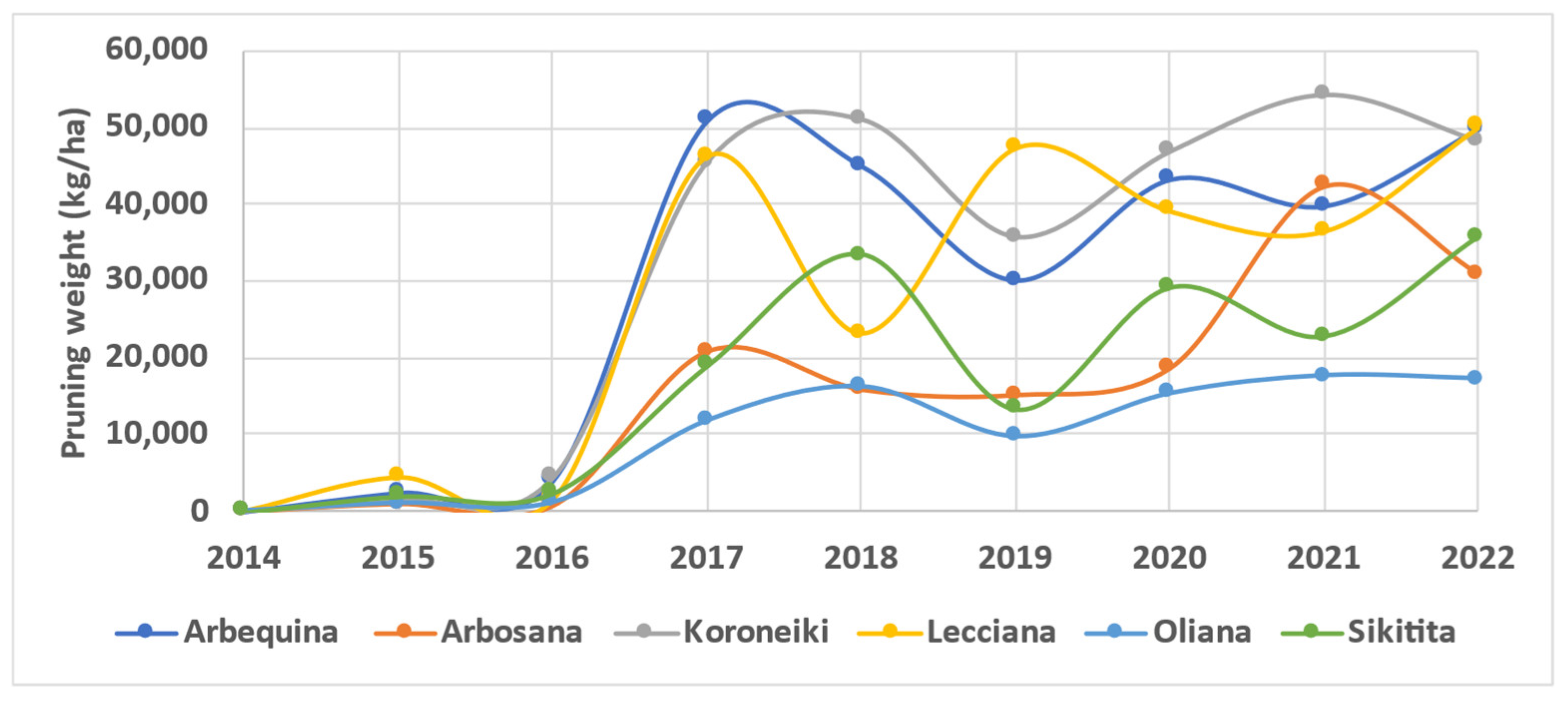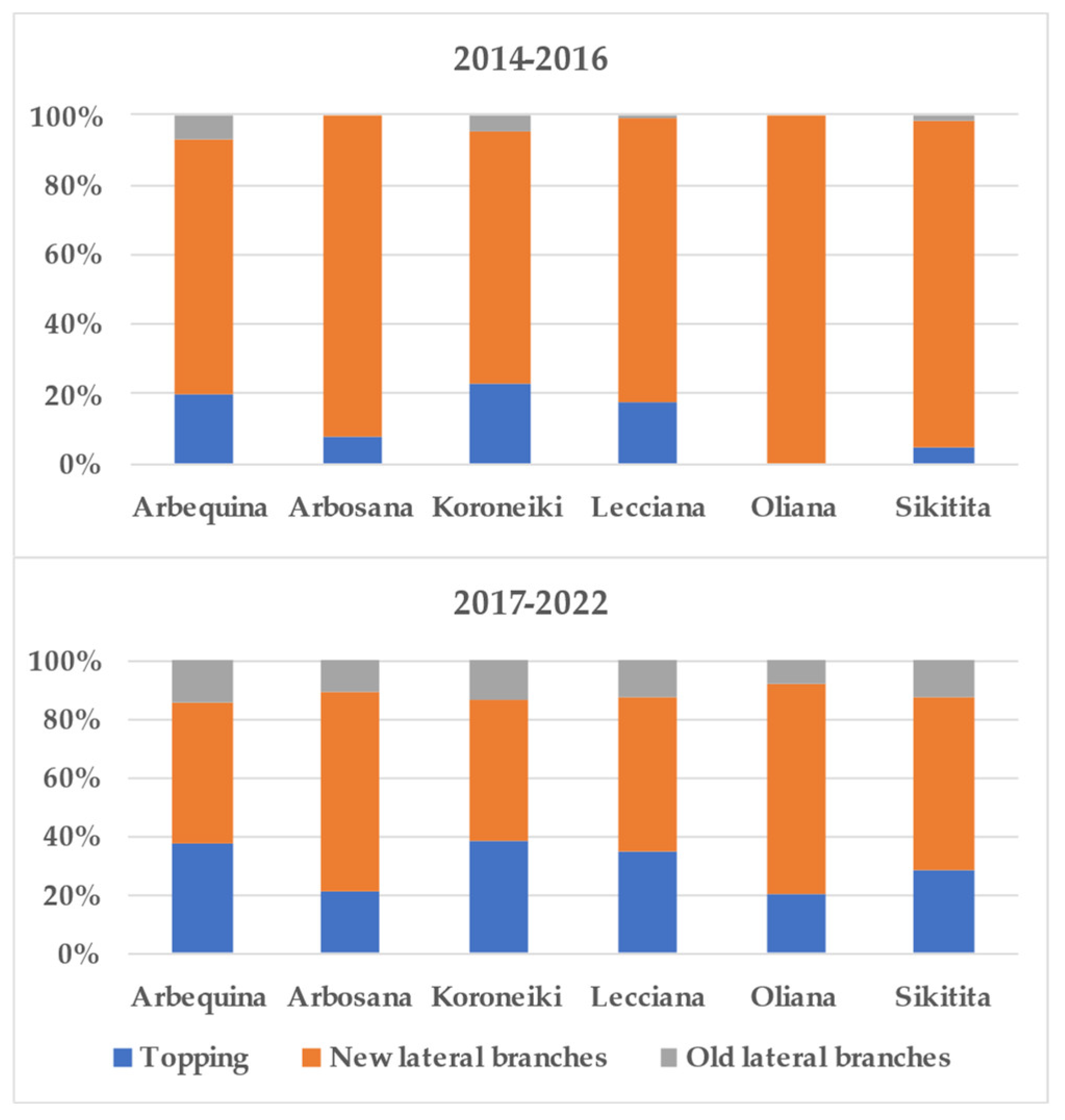Productivity and Vigor Dynamics in a Comparative Trial of Hedgerow Olive Cultivars
Abstract
:1. Introduction
2. Materials and Methods
2.1. Trial Description and Management
2.2. Measurements
2.3. Data Analysis
3. Results
4. Discussion
5. Conclusions
Supplementary Materials
Author Contributions
Funding
Institutional Review Board Statement
Data Availability Statement
Conflicts of Interest
References
- Lo Bianco, R.; Proietti, P.; Regni, L.; Caruso, T. Planting Systems for Modern Olive Growing: Strengths and Weaknesses. Agriculture 2021, 11, 494. [Google Scholar] [CrossRef]
- Lodolini, E.M.; de Iudicibus, A.; Lucchese, P.G.; Las Casas, G.; Torrisi, B.; Nicolosi, E.; Giuffrida, A.; Ferlito, F. Comparison of Canopy Architecture of Five Olive Cultivars in a High-Density Planting System in Sicily. Agriculture 2023, 13, 1612. [Google Scholar] [CrossRef]
- Rosati, A.; Paoletti, A.; Caporali, S.; Perri, E. The Role of Tree Architecture in Super High Density Olive Orchards. Sci. Hortic. 2013, 161, 24–29. [Google Scholar] [CrossRef]
- Camposeo, S.; Godini, A. Preliminary Observations about the Performance of 13 Varieties According to the Super High Density Oliveculture Training System in Apulia (Southern Italy). Adv. Hort. Sci. 2010, 24, 16–20. [Google Scholar]
- Lodolini, E.M.; Lucchese, P.G.; De Iudicibus, A. Canopy Growth and Architecture of Five Olive Cultivars for High-Density Orchards. In Proceedings of the XXXI International Horticultural Congress (IHC2022): International Symposium on Innovative Perennial Crops Management, Angers, France, 14–20 August 2023; pp. 275–282. [Google Scholar] [CrossRef]
- Centeno, A.; Hueso, A.; Gómez-del-Campo, M. Long-Term Evaluation of Growth and Production of Olive Cultivars in Super High-Density Orchard under Cold-Weather Conditions. Sci. Hortic. 2019, 257, 108657. [Google Scholar] [CrossRef]
- Grilo, F.; Novara, M.E.; D’Oca, M.C.; Rubino, S.; Lo Bianco, R.; Di Stefano, V. Quality Evaluation of Extra-Virgin Olive Oils from Sicilian Genotypes Grown in a High-Density System. Int. J. Food Sci. Nutr. 2019, 7486, 1–13. [Google Scholar] [CrossRef] [PubMed]
- Rallo, L.; Barranco, D.; de la Rosa, R.; León, L. ‘Chiquitita’ Olive. HortScience 2008, 43, 529–531. [Google Scholar] [CrossRef]
- Camposeo, S.; Vivaldi, G.A.; Montemurro, C.; Fanelli, V.; Cunill Canal, M. Lecciana, a New Low-Vigour Olive Cultivar Suitable for Super High Density Orchards and for Nutraceutical EVOO Production. Agronomy 2021, 11, 2154. [Google Scholar] [CrossRef]
- Vivaldi, G.A.; Strippoli, G.; Pascuzzi, S.; Stellacci, A.M.; Camposeo, S. Olive Genotypes Cultivated in an Adult High-Density Orchard Respond Differently to Canopy Restraining by Mechanical and Manual Pruning. Sci. Hortic. 2015, 192, 391–399. [Google Scholar] [CrossRef]
- Lodolini, E.M.; Polverigiani, S.; Zucchini, M.; Neri, D. Damages Induced by an Over-the-Row Harvester in Ten Cultivars in a High-Density Olive Orchard. Acta Hortic. 2022, 1346, 229–236. [Google Scholar] [CrossRef]
- Rosati, A.; Paoletti, A.; Lodolini, E.M.; Famiani, F. Cultivar Ideotype for Intensive Olive Orchards: Plant Vigor, Biomass Partitioning, Tree Architecture and Fruiting Characteristics. Front. Plant Sci. 2024, 15, 1345182. [Google Scholar] [CrossRef]
- Paoletti, A.; Rosati, A.; Famiani, F. Effects of Cultivar, Fruit Presence and Tree Age on Whole-Plant Dry Matter Partitioning in Young Olive Trees. Heliyon 2021, 7, e06949. [Google Scholar] [CrossRef]
- Di Vaio, C.; Marallo, N.; Marino, G.; Caruso, T. Effect of water stress on dry matter accumulation and partitioning in pot-grown olive trees (cv Leccino and Racioppella). Sci. Hortic. 2013, 164, 155–159. [Google Scholar] [CrossRef]
- Orgaz, F.; Testi, L.; Villalobos, F.J.; Fereres, E. Water Requirements of Olive Orchards–II: Determination of Crop Coefficients for Irrigation Scheduling. Irrig. Sci 2006, 24, 77–84. [Google Scholar] [CrossRef]
- Hoblyn, T.N.; Grubb, N.H.; Painter, T.H. Studies in Biennial Bearing. I. J. Pomol. Hortic. Sci. 1936, 14, 39–76. [Google Scholar] [CrossRef]
- Farinelli, D.; Tombesi, S. Performance and Oil Quality of “Arbequina” and Four Italian Olive Cultivars under Super High Density Hedgerow Planting System Cultivated in Central Italy. Sci. Hortic. 2015, 192, 97–107. [Google Scholar] [CrossRef]
- Larbi, A.; Ayadi, M.; Ben Dhiab, A.; Msallem, M.; Caballero, J.M. Olive Cultivars Suitability for High-Density Orchards. Span. J. Agric. Res. 2011, 9, 1279–1286. [Google Scholar] [CrossRef]
- Yılmaz-Düzyaman, H.; de la Rosa, R.; León, L. Seedling Selection in Olive Breeding Progenies. Plants 2022, 11, 1195. [Google Scholar] [CrossRef]
- Leon, L.; de la Rosa, R.; Barranco, D.; Rallo, L. Breeding for Early Bearing in Olive. Hortscience 2007, 42, 499–502. [Google Scholar] [CrossRef]
- Castro, A.I.D.; Rallo, P.; Suárez, M.P.; Torres-sánchez, J.; Casanova, L.; Jiménez-brenes, F.M.; Morales-sillero, A.; Jiménez, M.R.; López-granados, F. High-Throughput System for the Early Quantification of Major Architectural Traits in Olive Breeding Trials Using UAV Images and OBIA Techniques. Front. Plant Sci. 2019, 10, 01472. [Google Scholar] [CrossRef]
- Caruso, G.; Palai, G.; Marra, F.P.; Caruso, T. High-Resolution UAV Imagery for Field Olive (Olea Europaea L.) Phenotyping. Horticulturae 2021, 7, 258. [Google Scholar] [CrossRef]
- Rosati, A.; Paoletti, A.; Pannelli, G.; Famiani, F. Growth Is Inversely Correlated with Yield Efficiency across Cultivars in Young Olive (Olea Europaea L.) Trees. HortScience 2017, 52, 1525–1529. [Google Scholar] [CrossRef]
- Marino, G.; Macaluso, L.; Grilo, F.; Marra, F.P.; Caruso, T. Toward the valorization of olive (Olea europaea var. europaea L.) biodiversity: Horticultural performance of seven sicilian cultivars in a hedgerow planting system. Sci. Hortic. 2019, 256, 108583. [Google Scholar] [CrossRef]
- De la Rosa, R.; Leon, L.; Guerrero, N.; Rallo, L.; Barranco, D. Preliminary Results of an Olive Cultivar Trial at High Density. Aust. J. Agric. Res. 2007, 58, 392–395. [Google Scholar] [CrossRef]
- Villalobos, F.J.; Testi, L.; Hidalgo, J.; Pastor, M.; Orgaz, F. Modelling Potential Growth and Yield of Olive (Olea Europaea L.) Canopies. Eur. J. Agron. 2006, 24, 296–303. [Google Scholar] [CrossRef]
- Gómez-Gálvez, F.J.; Pérez-Mohedano, D.; de la Rosa-Navarro, R.; Belaj, A. High-Throughput Analysis of the Canopy Traits in the Worldwide Olive Germplasm Bank of Córdoba Using Very High-Resolution Imagery Acquired from Unmanned Aerial Vehicle (UAV). Sci. Hortic. 2021, 278, 109851. [Google Scholar] [CrossRef]
- Rosati, A.; Paoletti, A.; Al Hariri, R.; Morelli, A.; Famiani, F. Partitioning of Dry Matter into Fruit Explains Cultivar Differences in Vigor in Young Olive (Olea Europaea L.) Trees. HortScience 2018, 53, 491–495. [Google Scholar] [CrossRef]
- Ladux, F.J.; Cecilia Rousseaux, M.; Trentacoste, E.R. Characterization of Light Intensity and Quality, Vegetative, Flowering and Fruiting Traits in High and Super-High Density Olive Hedgerows. J. Saudi Soc. Agric. Sci. 2024, 23, 267–276. [Google Scholar] [CrossRef]





| Cultivar | Initial Canopy Vol (m3/ha) | Average Canopy Vol Incr (m3/ha) | Accumulated Pruning vol (m3/ha) | Accumulated Fresh Pruning Weight (kg/ha) | Average TCSA * Incr (cm2) | Accumulated Yield (kg/ha) | Bearing Index | Average Yield as % of Dry Mater | |||||||||
|---|---|---|---|---|---|---|---|---|---|---|---|---|---|---|---|---|---|
| 2014–2016 | Arbequina | 2987.8 | b | 6671.6 | a | 2645.4 | ab | 1629.7. | a | 11.2 | ab | 32,844.3 | ab | 69.5. | b | ||
| Arbosana | 1804.5 | cd | 4030.5 | cd | 1205.7 | c | 450.9. | b | 7.0 | c | 33,930.5 | a | 85.9. | a | |||
| Koroneiki | 2545.7 | b | 5612.3 | ab | 2254.6 | ab | 1428.5. | a | 11.4 | a | 33,421.9 | ab | 70.7. | b | |||
| Lecciana | 3753.5 | a | 6830.6 | a | 3061.7 | a | 1478.5. | a | 9.1 | bc | 32,603.5 | ab | 67.2. | b | |||
| Oliana | 1352.2 | d | 3116.6 | d | 934.0 | c | 529.2. | b | 4.5 | d | 27,368.6 | ab | 86.0. | a | |||
| Sikitita | 2012.3 | c | 5096.3 | bc | 1778.8 | bc | 1135.9. | ab | 10.1 | ab | 25,787.3 | b | 81.8. | a | |||
| 2017–2022 | Arbequina | 33,077.7 | a | 28,477.4 | a | 64,620.8. | a | 57.9 | ab | 70,709.9 | ab | 0.20 | b | 43.9. | c | ||
| Arbosana | 19,398.0 | bc | 16,567.8 | bc | 35,991.3. | bc | 43.4 | c | 83,331.8 | a | 0.19 | b | 62.6. | ab | |||
| Koroneiki | 31,428.2 | a | 26,893.2 | a | 70,414.3. | a | 66.8 | a | 64,450.4 | b | 0.24 | b | 42.6. | c | |||
| Lecciana | 24,602.6 | b | 20,714.0 | b | 60,694.2. | a | 52.0 | bc | 66,037.8 | b | 0.70 | a | 40.1. | c | |||
| Oliana | 14,760.4 | c | 12,643.6 | c | 21,983.6. | c | 24.9 | d | 78,208.8 | ab | 0.15 | b | 71.8. | a | |||
| Sikitita | 21,127.2 | b | 18,945.9 | b | 38,323.0. | b | 51.9 | bc | 73,493.5 | ab | 0.18 | b | 57.5. | b | |||
| Pruning Volume+1 | Fresh Pruning Weight+1 | Dry Pruning Weight+1 | Canopy Increment | TCSA ** | TCSA Increment | Yield | |
|---|---|---|---|---|---|---|---|
| Fresh pruning weight+1 * | 0.85 *** | ||||||
| Dry pruning weight + 1 | 0.81 | 0.97 | |||||
| Canopy increment | 0.99 | 0.86 | 0.84 | ||||
| TCSA | 0.80 | 0.80 | 0.75 | 0.82 | |||
| TCSA increment | 0.45 | 0.57 | 0.53 | 0.51 | 0.82 | ||
| Yield | −0.54 | −0.41 | −0.34 | −0.46 | 0.14 | −0.03 | |
| Yield as % of dry mater | −0.86 | −0.89 | −0.87 | −0.85 | 0.15 | 0.01 | 0.69 |
Disclaimer/Publisher’s Note: The statements, opinions and data contained in all publications are solely those of the individual author(s) and contributor(s) and not of MDPI and/or the editor(s). MDPI and/or the editor(s) disclaim responsibility for any injury to people or property resulting from any ideas, methods, instructions or products referred to in the content. |
© 2024 by the authors. Licensee MDPI, Basel, Switzerland. This article is an open access article distributed under the terms and conditions of the Creative Commons Attribution (CC BY) license (https://creativecommons.org/licenses/by/4.0/).
Share and Cite
Pérez-Rodríguez, J.M.; De la Rosa, R.; León, L.; Lara, E.; Prieto, H. Productivity and Vigor Dynamics in a Comparative Trial of Hedgerow Olive Cultivars. Agriculture 2024, 14, 1362. https://doi.org/10.3390/agriculture14081362
Pérez-Rodríguez JM, De la Rosa R, León L, Lara E, Prieto H. Productivity and Vigor Dynamics in a Comparative Trial of Hedgerow Olive Cultivars. Agriculture. 2024; 14(8):1362. https://doi.org/10.3390/agriculture14081362
Chicago/Turabian StylePérez-Rodríguez, Juan Manuel, Raúl De la Rosa, Lorenzo León, Encarnación Lara, and Henar Prieto. 2024. "Productivity and Vigor Dynamics in a Comparative Trial of Hedgerow Olive Cultivars" Agriculture 14, no. 8: 1362. https://doi.org/10.3390/agriculture14081362









